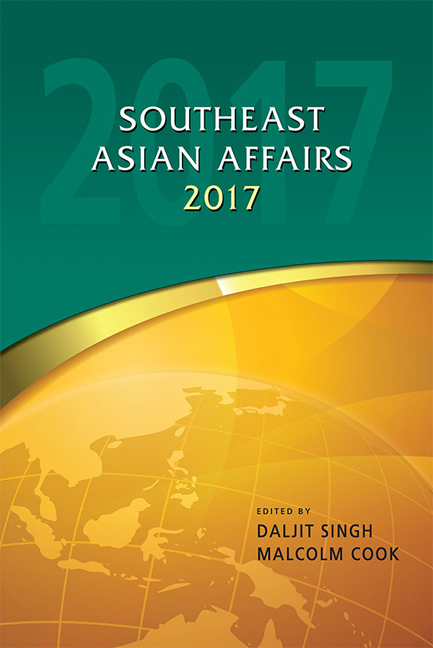Book contents
- Frontmatter
- Contents
- Foreword
- Introduction
- Acknowledgements
- THE REGION
- Southeast Asia in an Age of Strategic Uncertainty: Legal Rulings, Domestic Impulses, and the Ongoing Pursuit of Autonomy
- Southeast Asian Economies: In Search of Sustaining Growth
- Forging the ASEAN Economic Community, 2015 to 2016 — and Beyond
- Southeast Asia's Demographic Situation, Regional Variations, and National Challenges
- U.S.–Japan–Australia Strategic Cooperation in the Trump Era: Moving from Aspiration to Action
- Blurring the Distinction between Huaqiao and Huaren: China's Changing Policy towards the Chinese Overseas
- BRUNEI DARRUSALAM
- CAMBODIA
- INDONESIA
- LAOS
- MALAYSIA
- MYANMAR
- THE PHILIPPINES
- SINGAPORE
- THAILAND
- TIMOR-LESTE
- VIETNAM
U.S.–Japan–Australia Strategic Cooperation in the Trump Era: Moving from Aspiration to Action
from THE REGION
Published online by Cambridge University Press: 12 January 2018
- Frontmatter
- Contents
- Foreword
- Introduction
- Acknowledgements
- THE REGION
- Southeast Asia in an Age of Strategic Uncertainty: Legal Rulings, Domestic Impulses, and the Ongoing Pursuit of Autonomy
- Southeast Asian Economies: In Search of Sustaining Growth
- Forging the ASEAN Economic Community, 2015 to 2016 — and Beyond
- Southeast Asia's Demographic Situation, Regional Variations, and National Challenges
- U.S.–Japan–Australia Strategic Cooperation in the Trump Era: Moving from Aspiration to Action
- Blurring the Distinction between Huaqiao and Huaren: China's Changing Policy towards the Chinese Overseas
- BRUNEI DARRUSALAM
- CAMBODIA
- INDONESIA
- LAOS
- MALAYSIA
- MYANMAR
- THE PHILIPPINES
- SINGAPORE
- THAILAND
- TIMOR-LESTE
- VIETNAM
Summary
The U.S.–Japan–Australia Trilateral Strategic Dialogue (TSD) was the first formal trilateral security mechanism in the Asia-Pacific, and one of the earliest and most important nodes of what former U.S. Secretary of Defense Ashton Carter calls the “principled security network” that the United States and its partners have been constructing in the region. Since it was established in 2002 the TSD has become institutionalized at the ministerial level and has met twice at the leaders’ level, becoming the most developed and substantial trilateral involving the United States in the Asia-Pacific. Augmented in 2007 by a Security and Defense Cooperation Forum involving defence as well as foreign ministry officials, the TSD has developed into a useful mechanism for coordinating policy positions on regional issues such as North Korea and the South China Sea, and for driving deeper strategic cooperation between the three countries in areas including defence, security, intelligence, development assistance, capacity building, and humanitarian assistance and disaster relief (HADR). It has also helped to foster stronger defence and security ties between Japan and Australia — the weakest leg of the strategic triangle.
The strategic logic of trilateral U.S.–Japan–Australia defence and security cooperation remains compelling. Threats to the United States and its allies in the Asia-Pacific are intensifying — whether from North Korea's nuclear weapons and ballistic missile programmes, China's assertiveness in the Western Pacific (increasingly backed by sophisticated area denial weapons), or the resurgence of Islamist terrorist networks in Southeast Asia. These threats will increasingly stretch the constrained resources of the United States and its allies. The only cost-effective way to remedy the ensuing capability gaps in key areas such as intelligence, surveillance, and reconnaissance (ISR), undersea warfare, missile defence, and amphibious lift is to develop greater interoperability and, ultimately, integration among U.S. and allied military forces. Japan and Australia are two of the United States’ most capable and dependable allies in the region, as well as longstanding economic and diplomatic partners, who over the past decade have been steadily building their own substantial bilateral strategic relationship. Moreover, their respective strategic geographies complement each other and the United States’ maritime strategy in the Indian Ocean and Asia-Pacific region. Current trilateral defence cooperation focuses heavily on combined exercises, with the three countries steadily increasing the frequency, scale, and sophistication of their three-way exercise programme.
- Type
- Chapter
- Information
- Southeast Asian Affairs 2017 , pp. 83 - 100Publisher: ISEAS–Yusof Ishak InstitutePrint publication year: 2017



